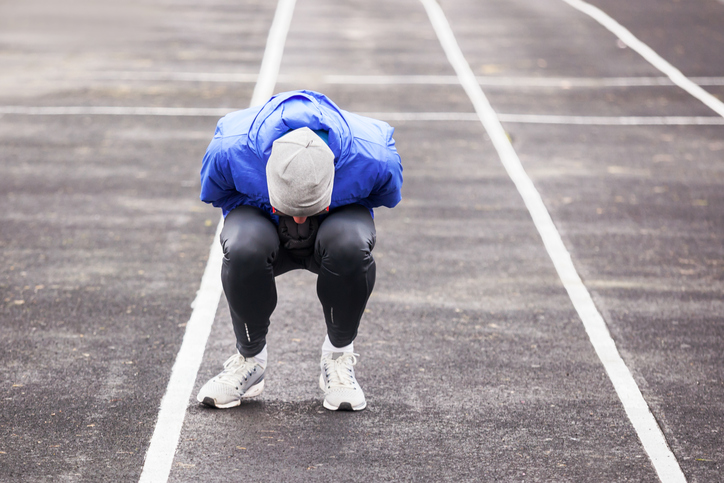The truth about Runs & Runs
article by Alice Hector Drummond Clinic Ambassador and Professional Triathlete
Exercise helps stimulate the digestive system, which is a good thing, to a point. As Roald Dahl so eloquently put in his version of The Three Bears:
“An early morning stroll / Is good for people on the whole/ It makes your appetite improve/ It also helps your bowels to move”.
Good working bowels are one thing, but there comes a point when digestive processes and strenuous exercise can clash, with cataclysmic results. It’s still a bit hushed up, but it’s believed around 93% of long distance triathletes will receive their ‘30 second warning’ at some point, and it’s also very common in long distance runners.
So first up, relax about it: you are not the only one. Secondly: there are methods we can employ to try and prevent it happening. Let’s start at the cause of the problem…
There are a few reasons why running, and triathlon running in particular, is thought to trigger such a reaction. The jostling action can certainly irritate the digestive system like no other exercise I’ve come across. The usual flow of blood to the intestines is diverted to major working muscles which can ‘trigger’ cramping and/or diarrhoea.
The added chance of dehydration on long runs can also cause stomach cramps, but then again, drinking a lot can certainly induce a sharp detour to the nearest clump of foliage. Hydration, therefore, becomes a fine balancing act. Add in the need to ‘eat on the go’ in triathlon – whilst operating at a relatively high intensity – and you’re suddenly demanding an awful lot from your stomach.
(Note, if an athlete says they suffered “stomach cramps”, that’s a euphemism. Again: you are not alone!)
Reduce the Risk:
- Avoid eating for at least two hours before you run. For triathlon races, I’ve found a ‘front-loading’ fuelling system on the bike leg works best, so eat and drink more in the first half of the bike, and allow your stomach to empty a bit in the second half, before you begin the run. On the run, sip on water and gels, rather than take large gulps. It takes me 3 sips on the run to get through a single gel, whereas on the bike, I down it in one. Simply pinch or fold the top of the gel or the water cup to stop it spilling out and allow you more time to run with it.
- Avoid excessive caffeine intake just before you train. Have coffee, but include it well before your run, and after drinking, wait for your ‘call of nature’ BEFORE heading out the door.
- Limit your intake of dairy products. Not one I’ve noticed has much of an effect, but something that’s often recommended by dieticians. Try it for yourself and see.
- Limit high-fibre foods in the days before a key race. Counter-intuitive for a healthy lifestyle perhaps, but ‘de-bulking’ temporarily can work wonders.
- Drink plenty of fluids so you start any run well-hydrated, but LIMIT in the hour before.
- If all other precautions fail, for races or key sessions, consider the use of an anti-diarrhoea product such as Imodium. Studies have shown this has reduced problems related to exercise-induced diarrhoea. It is not recommended to use regularly.
- In long distance races or sessions where you may be at risk, do not wear a one piece tri suit for obvious reasons. Shorts are far easier to drop in an emergency!
- If the problem is persistent despite these measures, you may want to consider a medical check-up.
EMERGENCY ACTION PLAN
- Panic not. First up, it is what you make it. We all remember our ‘first time’. That’s always quite traumatic. But it is what it is. Laugh about it, talk about it, trivialise it, and you’ll find no one cares and many can relate.
- Reduce Speed. If you’re struggling to find a place to go, reducing to a slower pace or a walk will provide some relief.
- Take Refuge. I’ve always found a ‘secret place’ in training sessions and races. Don’t be afraid to hop off the course to save your dignity. Chances are there won’t be a porta-loo right there when you need one, so you’ll need to think outside the box. Racing in an urban area? Then you’ll be heading past café’s and restaurants. In the countryside? No worries: bushes are even quicker. Seek and ye shall find.
- Choose discretion. On a trail, always go off the beaten track and bury your business – do not leave it on public routes, for obvious hygiene reasons.
- Pause your Garmin. Now I’ve become regularly accustomed to the process (de-ja-poo?), I barely acknowledge it when training. Whilst run sessions may include a 30 second unscheduled stop, it rarely impacts upon me completing successfully. That’s how little of a deal it is.

